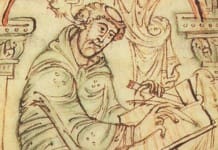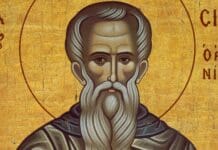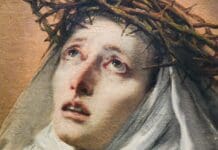 Among the Church’s contemplatives, St. John is one of the acknowledged masters of mystical theology. Indeed, perhaps no other writer has had greater influence on Catholic spirituality. Together with St. Teresa of Avila, he founded the Discalced Carmelites, an order devoted to service of the Blessed Mother through prayer and penance.
Among the Church’s contemplatives, St. John is one of the acknowledged masters of mystical theology. Indeed, perhaps no other writer has had greater influence on Catholic spirituality. Together with St. Teresa of Avila, he founded the Discalced Carmelites, an order devoted to service of the Blessed Mother through prayer and penance.
Born Juan de Yepes y Alvarez in Fontiveros, Spain, in 1542, John was the son of a wealthy silk merchant, Gonzalo de Yepes, and a poor weaver girl, Catalina Alvarez. The Yepes family disowned John’s father for marrying beneath his station, and the young couple lived in hardship, following the trade of silk weaving. John was the youngest of three sons. Shortly after his birth, Gonzalo died after a long illness, and Catalina struggled heroically to provide for her sons, settling in Medina del Campo.
Young John attended a school for poor children there, gaining a basic education and the opportunity to learn skills from local craftsmen. When he was 17, he began to work at the Plague Hospital de la Concepcion, and its founder offered to let him attend the Jesuit College, so long as he did not neglect his hospital duties. From 1559 to 1563, John studied with the Jesuits, learning Latin, Greek, and other subjects. He was offered the chance to study for the secular priesthood, which would have given him material security, but he felt God was calling him to Religious life. At age 20, he entered the Carmelite Order, being clothed with the habit on February 24, 1563, and taking the name Juan de Santo Matia (John of Saint Matthias). John did continue his studies, however, notably at the University of Salamanca, which was noted for its excellent professors of Thomist philosophy–an influence which is apparent throughout his writings. An outstanding scholar, John taught classes while still a student. He was ordained in 1597, and said his first Mass in Medina del Campo. During that trip, he first met Teresa of Avila, and she encouraged him to promote her reform among the men’s Order.
In November, 1568, John and three other friars took up the observance of the primitive Carmelite Rule in a farmhouse near Duruelo. At that time, he changed his name in religion to Juan de la Cruz (John of the Cross). The small band soon came to be known as *Discalced* (shoeless) Carmelites, because they went barefoot as a sign of their commitment to poverty. Their poverty was very real: the first house was barely more than one room, and the young community suffered many privations. When St. Teresa was ordered to return to the Convent of the Incarnation as its superior, she called upon John to assist her in renewing the large community, which had grown quite lax. Arriving there in 1572, he became the spiritual director of the nuns, including Teresa herself. For unknown reasons, the attitude of the original (“Calced”) Carmelites began to change toward the reformers. Whereas they had initially acquiesced and even encouraged the movement, the Chapter of 1575 placed severe restrictions on it, they now forbade any further foundations and ordered Teresa to choose one monastery as her permanent residence and remain there.
When in 1576 the Discalced Friars convened their own Chapter, the Calced moved to carry out the prohibitions of 1575. They arrested John and another friar and imprisoned him in a Calced monastery in Toledo in a windowless 6′ x 10′ room. Scourged and humiliated, he nonetheless refused to renounce the Reform. He passed the time in his cell composing the sublime lyric poems which form the basis of his mystical treatises. After some months, he managed to escape to the south of Spain, where he had been elected Prior of the monastery at El Calvario and appointed director of the nuns at Beas. In 1579, he became Rector of the new Discalced Carmelite college near the University of Baeza.
In 1580, the Holy See granted the Discalced the right to erect their own Province, although complete independence from the Calced did not come until 1593.
During these “middle years” of John’s life, he filled a variety of offices within the reformed Order, wrote the commentaries on his poems elucidating the mystical life, gave spiritual direction, and lived a life of deep union with God. Toward the end of his life, he disagreed with the new General, Nicholas Doria, about some changes in the Order. He was sent to the solitude of La Penuela in August, 1591 –in truth overjoyed to be relieved of administrative duties for the first time in years. But his peace was disturbed by news that a move was afoot to expel him from the Reform he had founded. His detractors tried to gather evidence against him to defame his character.
John fell ill after only a month at La Penuela, however. When urged to seek medical attention, he went to the monastery at Ubeda, where the Prior received him coldly, placed him in the worst cell in the house, and complained bitterly about the expense of caring for him. John grew worse, and, realizing his time was short, he called for the Prior to beg forgiveness for all the trouble he had caused him. Instead, the Prior, realizing John’s holiness and his own hardheartedness, wept. John died as he had prayed to: without honors, without material comforts, and with great suffering.
He was 49. He was beatified in 1675, canonized in 1726, and declared a Doctor of the Church in 1926. Among his classic works are “The Ascent of Mount Carmel”, “The Dark Night”, “The Spiritual Canticle”, and “The Living Flame of Love”.
















